“Proof,” Policy, & Practice: Understanding the Role of Evidence in Improving Education
by Paul E. Lingenfelter
Science Blogging: The Essential Guide
by Christie Wilcox, Bethany Brookshire, and Jason G. Goldman, eds.
Knowledge and Discourse Matters: Relocating Knowledge Management’s Sphere of Interest onto Language
by Lesley Crane
Quantifying the User Experience: Practical Statistics for User Research, 2nd ed.
by Jeff Sauro and James R. Lewis
IT Project Management: A Geek’s Guide to Leadership
by Byron A. Love
The Online Teaching Survival Guide: Simple and Practical Pedagogical Tips, 2nd ed.
by Judith V. Boettcher and Rita-Marie Conrad
Assembling Arguments: Multimodal Rhetoric and Scientific Discourse
by Jonathan Buehl
How To Be A Writer: Conversations with Writers about Writing
by David Quantick
Facebook for Dummies
by Carolyn Abram
The Wiley Handbook of Learning Technology
by Nick Rushby and Daniel W. Surry, eds.
System: The Shaping of Modern Knowledge
by Clifford Siskin
Reason & Rigor: How Conceptual Frameworks Guide Research, 2nd ed.
by Sharon M. Ravitch and Matthew Riggan
Odyssey—The Business of Consulting: How to Build, Grow, and Transform Your Consulting Business
by Imelda K. Butler and Dr. Shayne Tracy
The Word Detective: Searching for the Meaning of It All at the Oxford English Dictionary: A Memoir
by John Simpson
How the Brain Processes Multimodal Technical Instructions
by Dirk Remley
The Book: A Cover-to-Cover Exploration of the Most Powerful Object of Our Time
by Keith Houston
Organizations, Communication, and Health
by Tyler R. Harrison and Elizabeth A. Williams, eds.
The Study of Language, 6th ed.
by George Yule
“Proof,” Policy, & Practice: Understanding the Role of Evidence in Improving Education
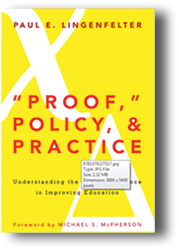 Paul E. Lingenfelter. 2016. Sterling, VA: Stylus Publishing. [ISBN 978-1-57922-751-7. 262 pages, including index. US$29.95 (softcover).]
Paul E. Lingenfelter. 2016. Sterling, VA: Stylus Publishing. [ISBN 978-1-57922-751-7. 262 pages, including index. US$29.95 (softcover).]
In education, policy makers and practitioners—educators at various levels from boards to classrooms—look to social scientists and researchers to tell them “what works.” While each of these professional specialties share the goal of improving educational outcomes, their working relationship is uneasy, and the resulting educational initiatives and interventions rarely deliver the promised results, and often have unintended, and even undesirable consequences.
With “Proof,” Policy, & Practice: Understanding the Role of Evidence in Improving Education, Lingenfelter hopes to improve the situation by showing how evidence is used (and misused) in forming and applying educational policy, and by helping each of the professional specialties better understand each other’s needs, methods, capabilities, and concerns so, working together, they might become more successful.
The author draws on a lifetime of experience and a wide, deep familiarity with the relevant programs and literature to elucidate both the promise and limitations of what research can deliver. Lingenfelter covers all the necessary bases from a variety of perspectives, explaining such things as the kinds of evidence (qualitative, quantitative) that can be gathered, the purposes to which it can be applied (assessment for improvement, assessment for accountability), and how it gets used (and often misused) to design policy interventions. His deep understanding, clear-eyed analysis, and even-handed presentation of where things work and how things go wrong contributes much to the book’s value.
Lingenfelter examines the research environment and makes valuable suggestions for how researchers might better tailor their research to give policy makers and practitioners the relevant and applicable information they need.
He also shows that good research is not enough. When policy interventions get applied, problems arise. Almost any intervention, including testing itself, can have unintended consequences such as the perverse incentives to game the system that grew out of the No Child Left Behind’s high-stakes testing. Beyond that, evidence and policy initiatives don’t function in a vacuum but in an environment of government and organizations, where individuals and institutions have unique perspectives and interests to protect. Lingenfelter identifies and provides an insightful, fair-minded discussion of the many economic, political, emotional, and tribal issues that come in to play.
Yet, while the issues are daunting, Lingenfelter delivers a hopeful book that argues that improvement is possible if pitfalls are avoided. He wraps it all up with a chapter of reflections, observations, and opinions on “What Works, When, and How” (p. 178), in which he keys his points back to relevant sections of the main text.
Whether you are professionally involved in educational reform, or are just interested in a better understanding of the issues, “Proof,” Policy, & Practice has much to offer.
Patrick Lufkin
Patrick Lufkin is an STC Associate Fellow with experience in computer documentation, newsletter production, and public relations. He reads widely in science, history, and current affairs, as well as on writing and editing. He chairs the Gordon Scholarship for technical communication and co-chairs the Northern California technical communication competition.
Science Blogging: The Essential Guide
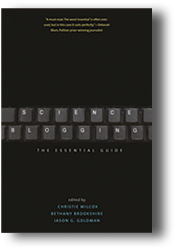 Christie Wilcox, Bethany Brookshire, and Jason G. Goldman, eds. 2016. New Haven, CT: Yale University Press. [ISBN 978-0-300-19755-6. 270 pages, including index. US$24.00 (softcover).]
Christie Wilcox, Bethany Brookshire, and Jason G. Goldman, eds. 2016. New Haven, CT: Yale University Press. [ISBN 978-0-300-19755-6. 270 pages, including index. US$24.00 (softcover).]
Accurate, effective science communication is an important aspect of societies worldwide; however, how science is communicated to the public or used in making policy is extremely controversial. For those interested in the more altruistic aspects of science communication or who just want to be a science writer, it might be worthwhile to explore science blogging. Science Blogging: The Essential Guide is a comprehensive and informative book about online science communication that can benefit and be appreciated by both novice and experienced science writers. Each chapter is self-contained, so depending on interest, experience, and goals, readers can read the book straight through or choose whichever chapters most relate to what they want to learn or achieve.
To stand out in a field that is as established and widespread as science communication, online science writers have to find a niche and earn a reputation as trustworthy experts, of which this book has no shortage of ideas. Beginning with a chapter on whether blogging is right for you, Science Blogging has 26 short, easy-to-read chapters that help readers understand the unique aspects of this writing style. The organized chapters take readers on an exploratory journey from learning the logistics of setting up a blog and building a following to maintaining a distinctive presence through an interactive blog, joining an online science network, blogging about controversial topics, and promoting a blog through social media. Science is traditionally a male-dominated discipline, so the chapters devoted to the unique challenges that minority and women science writers face clear the way for new voices to permeate the field. Likewise, student, tenure-track faculty, and institutional bloggers face their own challenges and are addressed in independent chapters. And since a blog’s success is measured by traffic and commentary, there are chapters on metrics, managing comments, and dealing with “Deniers, Cynics, and Trolls” (p. 224).
This book has many strengths, such as the comprehensive coverage, the experienced contributors that wrote their chapters in an engaging and informative style very similar to the advice they give, and the collective list of online resources throughout the book. Now that science writing classes are part of many professional and technical writing programs and journalism departments, Science Blogging is a must read for undergraduate and graduate classes in those programs. Science students often are limited on the number of writing classes they can fit into their program of study. It could be beneficial for these students to learn about and practice the craft of science blogging academically and professionally to strengthen their writing and communication skills. Similarly, practicing scientists and journalists could use this style of writing to make advancements in the overall communication of science to the public and their peers.
Diane Martinez
Diane Martinez is an assistant professor of professional and technical communication at Western Carolina University. She previously worked as a technical writer in engineering, an online writing instructor, and an online writing center specialist. She has been with STC since 2005.
Knowledge and Discourse Matters: Relocating Knowledge Management’s Sphere of Interest onto Language
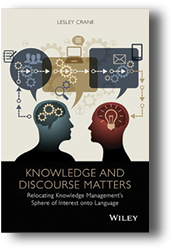 Lesley Crane. 2016. Hoboken, NJ: John Wiley & Sons, Inc. [ISBN 978-1-118-93185-1. 308 pages, including index. US$110.00.]
Lesley Crane. 2016. Hoboken, NJ: John Wiley & Sons, Inc. [ISBN 978-1-118-93185-1. 308 pages, including index. US$110.00.]
We have heard of knowledge management (KM) for many years, even decades. Organizations hire knowledge managers; philosophers write about and discuss epistemology; biologists and neuroscientists examine the development of knowledge in the brain; psychologists look into the impact on persons and cultures; and so forth. Rarely do these groups try to define what knowledge is and how it occurs.
Crane divides Knowledge and Discourse Matters: Relocating Knowledge Management’s Sphere of Interest onto Language into two parts: Part 1 reviews previous attempts to define knowledge and summarizes various theories of knowledge management, and Part 2 centers on research with an emphasis on the social construction of meaning. There are 17 chapters: 11 in Part 1 and 6 in Part 2.
Once Crane completes the review of definitions and theories that serve as background for her research project, she gets to the book’s main point: examining the need for research into KM and how to go about doing it. The connection to the title comes when she describes what to use to do the research. The subtitle suggests her view that we need to recast the discussion away from previous views to one that links KM to language, specifically, discourse analysis. A major problem not completely resolved in both the literature and Crane’s book is what is knowledge. When do you have knowledge rather than data or information? Is knowledge something “out there” to be discovered and labeled? How does it differ from information or even wisdom. Subjective? Objective? These are some of the problems she discusses in Part 1.
Crane argues that because knowledge resides in both text and talk within an organization, the problem is knowing just what to manage and to what end. Then, in Part 2, she describes her research using discursive psychology to analyze knowledge sharing meetings in two organizations in central London. Crane’s focus has been on particular elements of knowledge sharing: identity, trust, risk, and context. Based on an analysis of transcripts, she claims that the speakers are aware of these issues and that their discussion or knowledge sharing actions are influenced by the direction and scope of these actions.
The value of Crane’s Knowledge and Discourse Matters for advanced undergraduate and graduate students who are studying knowledge and information management and are wanting to do research lies in the literature review and history of the term and her summarizing various KM theories. Practicing technical communicators could focus on Part 2 where she applies what she develops in Part 1 to specific situations. The first group should be familiar with scholarly writing, both content and style and have no trouble understanding, while the second will find it difficult to find and understand the information that they need. Members of the first group should use it as a class text, while members of the second should recommend it for the company library.
Tom Warren
Tom Warren is an STC Fellow, Jay R. Gould Award for Excellence recipient, and professor emeritus of English (technical writing) at Oklahoma State University, where he established the BA, MA, and PhD technical writing programs. Past president of INTECOM, he served as guest professor at the University of Paderborn, Germany.
Quantifying the User Experience: Practical Statistics for User Research
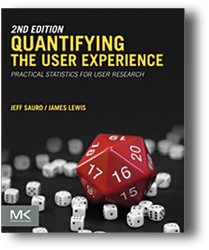 Jeff Sauro and James R. Lewis. 2016. 2 nd ed. Cambridge, MA: Morgan Kaufmann. [ISBN 978-0-12-802308-2. 350 pages, including index. $54.95 (softcover).]
Jeff Sauro and James R. Lewis. 2016. 2 nd ed. Cambridge, MA: Morgan Kaufmann. [ISBN 978-0-12-802308-2. 350 pages, including index. $54.95 (softcover).]
Quantifying the User Experience: Practical Statistics for User Research is the definitive book on inferential statistics for usability researchers. The authors present the equations, discussions, and examples for and in the context of usability studies, primarily usability testing.
Need to justify having only a small number of participants in a usability test? Sauro and Lewis explain confidence intervals and show how to compute them.
Need to figure out how many people to include in a study to reach a specific level of confidence in what you learn? Sauro and Lewis show how to do that.
Wondering about the research related to standardized usability questionnaires? Sauro and Lewis have a whole chapter on that.
You can use Quantifying the User Experience as a self-study textbook in statistics for usability research or as a handbook to answer a specific need.
This is a very technical book with many formulas, lots of specialized vocabulary, and in-depth explanations. As Elisa Miller wrote in reviewing the first edition, having this book might have saved her “the cost of four semesters studying applied statistics” (Miller, Technical Communication, 60 (2), May 2013).
Sauro and Lewis provide a 15-page appendix as “a crash course in fundamental statistical concepts.” If terms like “central limit theorem,” “z-Scores,” and “t-Distribution” seem hazy to you, definitely start with the appendix.
Also, you don’t always have to work through the equations to use the tests. In many cases (as they tell you), Excel has a command that will run the test for you and Jeff Sauro’s site, www.measuringu.com, has a calculator for that situation.
To help you use Quantifying the User Experience as a textbook, Sauro and Lewis include problems (“chapter review questions”) at the end of each chapter and then give answers for you to check against what you did.
To help you use it as a handbook, they have four decision trees up front (pages 2 – 3). The decision trees lead to the appropriate statistical tests for different situations and tell you where in the book to learn about the tests.
If you are new to statistics and to quantitative usability studies, you might want to start with another Morgan Kaufmann book, Measuring the User Experience, by Tom Tullis and Bill Albert. You might also want to read the column on confidence levels by STC Fellow, Caroline Jarrett, at www.uxmatters.com. You would then likely feel more ready for Quantifying the User Experience.
If you own the first edition, the added value here is the new chapter on correlation, regression, and analysis of variance, and the updated work on standardized usability questionnaires.
Janice (Ginny) Redish
Janice (Ginny) Redish is president of Redish & Associates in Bethesda, MD. Ginny is an STC Fellow, Ken Rainey Award recipient, and former member of the STC Board of Directors. Ginny’s latest book is Letting Go of the Words – Writing Web Content that Works.
IT Project Management: A Geek’s Guide to Leadership
 Byron A. Love. 2017. Boca Raton, FL: Auerbach Publications. [ISBN 978-1-4987-3650-3. 232 pages, including index. US$49.95 (softcover).]
Byron A. Love. 2017. Boca Raton, FL: Auerbach Publications. [ISBN 978-1-4987-3650-3. 232 pages, including index. US$49.95 (softcover).]
IT Project Management: A Geek’s Guide to Leadership is designed to offer insight into the minds of your employer, employees, and coworkers. This insight should help you negotiate with people of different mindsets, temperaments, and backgrounds so you all can succeed in your careers. Particularly, this book focuses on IT projects and dealing with the potentially difficult personality of a “geek.”
To start, Love describes what it means to be a geek, both as an employer and an employee. The book’s intended audience is technical geeks everywhere, meaning intelligent people with a strong skill set and deep interests. Love takes the common idea that a geek is a socially inept person and a troublesome coworker, and demonstrates how that stereotype is exaggerated and that geeks make the best project managers, especially on IT projects. This theory is backed up with data from psychological research. For example, the book contains a table describing introversion/extroversion, body language, and an application of Maslow’s Hierarchy of Needs, as it applies to the career of an IT professional. After Love describes each scientific point, he breaks from theory and interjects an anecdotal story about a work event. These anecdotes are very detailed and contain descriptions of each theory. In each scenario body language is closely depicted in the story. Following each scenario, Love breaks down what happened and examines how the different characters acted and what they could have done differently to resolve the tension in the story. This technique of theory, example, and explanation runs throughout the book and does a great job of synthesizing key concepts into relatable knowledge. As the book progresses, it moves from a psychological study into more of a motivational guide, helping you alter your own habits to make yourself into a more useful project leader.
Overall, IT Project Management provides a good overview of the psychology of a workplace. If you are a manager, or are seeking to become one, this book may help you gain insight into both your employees and yourself. With that knowledge, Love hopes that you can improve your life and the lives of your coworkers, while leading them to success. Even if you do not consider yourself a geek, IT Project Management may help you work with people who do consider themselves one.
Timothy Esposito
Timothy Esposito is an STC Associate Fellow with over 15 years of technical communication experience. He is currently president of the STC Philadelphia Metro Chapter. Before becoming president, Timothy was chapter vice president, treasurer, webmaster, and scholarship manager.
The Online Teaching Survival Guide: Simple and Practical Pedagogical Tips
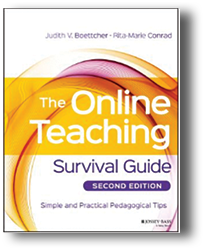 Judith V. Boettcher and Rita-Marie Conrad. 2016. 2nd ed. San Francisco, CA: Jossey-Bass. [ISBN 978-1119-1914-7688. 375 pages, including index. US$40.00 (softcover).]
Judith V. Boettcher and Rita-Marie Conrad. 2016. 2nd ed. San Francisco, CA: Jossey-Bass. [ISBN 978-1119-1914-7688. 375 pages, including index. US$40.00 (softcover).]
I have taught two online courses and wished I’d had this book before I taught them. But I probably wouldn’t have appreciated it as much. So if you are considering teaching an online class or have already taught some, I’d recommend this book for you.
According to Boettcher and Conrad, The Online Teaching Survival Guide: Simple and Practical Pedagogical Tips is intended for “instructors with limited access to faculty support services and for faculty with little or no experience in online instructional environments and, likely, little time to prepare for online teaching” (p. xxvi). Of course, this likely includes adjuncts (like me) and graduate students as well as a good many technical communicators who may teach a class on the side.
Even though the book is based on “tips” as the subtitle indicates, it follows a structure based on the beginning, middle, and end of a regular semester-long course. This was not particularly helpful to me, since I teach in an accelerated environment, but to the authors’ credit, they do have a separate chapter on “Teaching Accelerated Intensive Courses.”
The Online Teaching Survival Guide was helpful in confirming many of the things that I had thought or experienced while teaching online. Among them was the fact that the teaching role shifts dramatically from leader to facilitator. The teacher still determines most of the things about a class—grading, topics, resources, due dates—but you are no longer guiding the discussion. You may get to ask the question, but after that the online discussion takes on a life of its own. That’s not necessarily bad, but it is different. And it may be good, in that all students have to talk and cannot hide behind others.
Another important fact that Boettcher and Conrad discuss is presence. Online faculty have to be present in an online class in some way, every day. I haven’t learned how to do this yet successfully and still do all the other things I have to do, including a full-time technical communication job.
They also stress the importance of videos in both teaching and as resources. Sitting in front of a camera is quite a bit different than lecturing. You don’t have faces to look at and react to, unless you have the technology to do that, and you may. But this brings up one of my criticisms of the book.
I believe that teaching online is substantially different than teaching in person, and I don’t think the authors necessarily address that. And in particular, the fact that students can act much differently online than they do in person. There is something about the online medium that removes inhibitions, and that can be good or bad, depending upon the person.
Other than that, and the presence of too many tables in The Online Teaching Survival Guide, I recommend it wholeheartedly.
Charles R. Crawley
Charles R. Crawley is an adjunct professor at Mount Mercy University in Cedar Rapids, Iowa, and as much as he hates to admit it, longs for the good ole days.
Assembling Arguments: Multimodal Rhetoric and Scientific Discourse
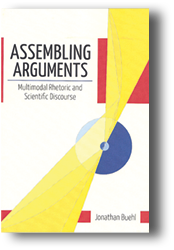 Jonathan Buehl. 2016. Columbia, SC: University of South Carolina Press. [ISBN 978-1-61117-561-5. 282 pages, including index. US$59.95.]
Jonathan Buehl. 2016. Columbia, SC: University of South Carolina Press. [ISBN 978-1-61117-561-5. 282 pages, including index. US$59.95.]
Buehl’s Assembling Arguments: Multimodal Rhetoric and Scientific Discourse deconstructs how scientists use textual and visual “modes” (hence, “multi-modal rhetoric”) to assemble evidence, develop arguments, and circulate arguments within their discourse community. Science’s importance in modern society makes such studies crucial. To develop a framework for multimodal communication and support pedagogy, Buehl describes how scientists select evidence to support their arguments. In so doing, he accounts for how visuals create meaning and the importance of audience and community. His conception–assembly–circulation model unites these processes within cognitive, material, and social domains. He provides enough theoretical erudition to satisfy academics, including some whose theories are (charitably) abstruse, and enough practicality to satisfy practitioners. Unfortunately, the balance may satisfy neither; the result is both sophisticated and practical.
Buehl begins by summarizing modern rhetorical theory, which he expands to include graphics, a neglected rhetorical component. Ironically, these 36 dense pages contain no supporting visuals (apart from two plates). Omitting Bertin’s Semiologie Graphique and Tufte’s work undermines his discussion of visual grammar. Nonetheless, this is deconstruction done right, illuminating rather than concealing. Importantly, he notes the emergent behavior of text and images: meaning often evolves in unanticipated ways. Buehl doesn’t insist on discrete categories; rather, his categories overlap and iteratively modify each other as rhetors craft and revise their rhetoric. Left implicit until later is how scientists use this approach to extract meaning while assembling their evidence. Assembling Arguments is appropriately illustrated, but Buehl creates no new graphics to show his model’s ability to improve communication.
Scientists value “elegance,” which biases them toward certain visualizations. Buehl reminds us that even objectively choosing evidence influences our thoughts and what conclusions satisfy. Visualizations “model” data—they are not the data itself—and shape what we see and ignore. This has ethical significance: in deciding what evidence to include and exclude, communicators risk concealing inconvenient or contradictory evidence. Recognizing this inevitable subjectivity decreases the risk of self-deception. Buehl repeatedly demonstrates how the scientific discourse community influences how scientists assemble arguments, including assumptions about what constitutes facts and truth and how this shapes arguments and the signifiers that support them. Scientists tend to neglect the social context in which they’re embedded, but truth does not speak for itself; the audience defines it.
Rigorously researched examples show how scientists revised their rhetoric to achieve persuasion by conceiving, assembling, and circulating knowledge, thereby demonstrating Buehl’s model. Buehl writes clearly and well, with profound understanding of science’s history and philosophy, but his jargon-heavy text will dissuade many scientists who would benefit from Assembling Arguments. Conversely, the first case study’s dense equations will dissuade many rhetoricians. The book’s cramped type exacerbates the effect, creating intimidating pages.
Buehl’s model matches my experience redesigning the text and graphics for 6000+ science manuscripts. The model should now be applied prescriptively rather than descriptively to test its utility. Chapter 14 begins this task, but at only 8 pages, does not codify a pedagogical model for teachers.
Rhetoric and science are both ways to approach truth. They’re a powerful combination if rhetoricians and scientists can learn from each other. Assembling Arguments will help.
Geoff Hart
Geoff Hart is an STC Fellow with more than 28 years of writing, editing, translation, and information design experience. He is the author of two popular books, Effective Onscreen Editing and Writing for Science Journals.
How To Be A Writer: Conversations with Writers about Writing
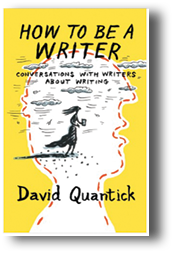 David Quantick. 2016. London, UK: Oberon Books. [ISBN 978-1783199037. 220 pages. US$23.95 (softcover).]
David Quantick. 2016. London, UK: Oberon Books. [ISBN 978-1783199037. 220 pages. US$23.95 (softcover).]
At first glance, How To Be A Writer: Conversations with Writers about Writing seems to be another instructional manual on becoming a writer. Yet this book is different because Quantick defines through the insights of writers themselves what it means to be a writer. The reader cannot come away from the book without gaining a deeper appreciation for writers and a broader understanding of the craft. Quantick’s quick wit also gives the reader some chuckles along the way.
In his introduction, Quantick loosely cites How To Be A Writer as a sequel to his book How To Write Everything. In his desire to author another book on writing, he wanted to emphasize what it takes to exist as a writer, to “be” a writer. “Everyone can write, to some degree – but not everyone is a writer” (p. 1). He clarifies that a writer is “someone whose daily life, whose routines and whose calendar all revolve around the fact that they write.” Quantick explains that there are “two strands” in How To Be A Writer. “One is a writer’s day and the other is talking about writing in general” (p. 176). Both strands are accomplished well as the author uses interviews to expose the thoughts and quirks of writers and their daily rituals, frustrations, and rewards.
Following the introduction are twelve neatly structured chapters, each focusing on one interview. Quantick begins each chapter with a clever title taken from an interview quote, a personal introduction of the interviewee, a series of questions and answers, and ends with a commentary. He interviews well-known writers including Emma Donoghue (Room) and Jon Ronson (The Men Who Stare at Goats), columnists, television writers, crime writers, a literary agent, and even his personal accountant. The result is eclectic, entertaining, and educational.
The interviews stay true to the title, reading more like conversations as the subjects speak intimately and frankly on the business of writing. Quantick’s questions vary by profession, but he spends quality time on each personal experience. Answers to his questions on daily routine, balancing family with work, and generating ideas for writing dismiss the notion that writers stay in pajamas all day, writing endlessly. A writer’s day is revealed as very structured with meetings, e-mails, carpools, and kids. But there is always a set, special time for writing, intentional and necessary.
How To Be A Writer is highly helpful for writers, but Quantick’s humor makes it a good read for anyone. Even though a technical writer is not interviewed, the personal experiences described in the book are identifiable to technical writers or anyone who writes for a living. The book effectively shows that sustainability is needed in maintaining a career as a writer. “How do you get to be a writer? It’s easy,” Quantick states. “You just have to write” (p. 216).
Valerie Whaley
Valerie Whaley is a technical communication graduate student at the University of Alabama in Huntsville with an interest in training manuals and procedures. After a decade in the print media industry, she now uses her writing and training skills in the classroom as an elementary school substitute teacher.
Facebook for Dummies
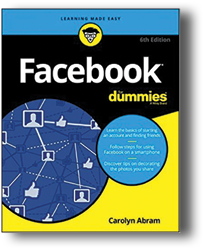 Carolyn Abram. 2016. Hoboken, NJ: John Wiley & Sons, Inc. [ISBN 978-1-11917-903-0. 370 pages, including index. US$21.99 (softcover).]
Carolyn Abram. 2016. Hoboken, NJ: John Wiley & Sons, Inc. [ISBN 978-1-11917-903-0. 370 pages, including index. US$21.99 (softcover).]
Abram gives us the lowdown on Facebook (FB) basics with the insight gained from being the very first Facebook user and then a company employee. The amount of information in this 370-page Facebook for Dummies could be overwhelming to a first-time user. Instead, consider this as a guide to help you create a FB account in a few steps, find and invite friends, follow people you are interested in, and communicate using one of the most popular social media sites in the world.
In the process, your vocabulary will expand with words like: friend requests, news feed, posts, blocking, milestones, events, groups, and lists. In Chapter 3, Abram points out software features located in layers and navigation tabs with functionality depending on the screen viewed . . . and whether on computer or mobile phone (see Chapter 7). Screen captures are an important component since multiple ways are available to access the same function.
Your typical day’s activities, according to Chapter 4, will be to check the news feed, like a post, follow a person, post your status, limit who can view posts, or upload single photos or an album. FB is also ideal for locating old friends and classmates. For example, you might find a former spouse who moved across country when you were both younger. Now may be just the right time to restart a relationship.
When you want to get serious about FB, you can customize privacy and other settings using information in Chapter 6, track the number of friends you have and people who follow you, then create lists (Chapter 8) and groups (Chapter 10) to simplify communication, or schedule posts and events (Chapter 12). With help from the Index, you can troubleshoot any stubborn points about FB you haven’t been able to resolve. For example, did you know that you can belatedly view friends’ birthdates by checking a previous month in the calendar?
For technical writers, learning how to create a separate page for self-promotion or interfacing with your company’s users may be an assignment you’ve been avoiding. Procrastinate no longer, since Chapter 13 walks you through the process. You’ll soon be an expert, assigning page roles to fellow employees and changing settings regarding whether customers can post. Use the settings tab in the blue bar at the top of the page . . . not in the drop-down menu.
The last chapters of Facebook for Dummies offer specific advice for gamers, students, and parents. The “Ten Frequently Asked Questions” chapter (Chapter 17) is guaranteed to provide new users with answers. But you already knew that, right?
Donna Ford
Donna Ford has been an STC member, joining in 1990 and serving on her local chapter’s board for many years. She has been a technical writer since 1987 in the hardware, software, and government healthcare industries. Donna holds a certificate in Information Design from Bentley College. She also reviews books online for the US Review of Books.
The Wiley Handbook of Learning Technology
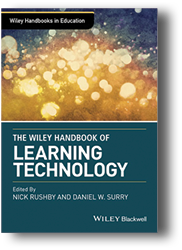 Nick Rushby and Daniel W. Surry, eds. 2016. Malden, MA. John Wiley & Sons, Ltd. [ISBN 978–1–118–73643–2. 596 pages, including index. US$195.00.]
Nick Rushby and Daniel W. Surry, eds. 2016. Malden, MA. John Wiley & Sons, Ltd. [ISBN 978–1–118–73643–2. 596 pages, including index. US$195.00.]
This review should celebrate a high-quality collection that effectively works to recenter educational technology and its practitioners back to their original purpose and goal: supporting learning. The thorough index and book’s clear organization make for easy use. Clear chapter breaks and construction support skimming and reading, while diagrams and figures are easy to understand and use. The content ranges from mapping the field (Chapter 1) and defining technology (Chapter 3) to addressing multiple situations for learning technologies (Chapters 7–10) as well as utopian (Chapter 29) and apocalyptic visions (Chapter 28) of technology in learning. There appears to be nothing missing—unless you or some of your learners are disabled or have some form of sensory loss or cognitive variance.
This radical shortcoming seeps into almost every chapter. Accessibility is absent from nearly 600 pages with few exceptions: several mentions of W3C, a reference to deaf and blind learners, and a reference to cognitive and physical disabilities. Chapter 15, How to Succeed with Online Learning, has a short section about addressing special needs, but that’s it. Chapter 20, The Design of Learning, mentions Universal Design for Learning, a process closely related and connected to many aspects of accessibility—but there’s no mention of accessibility. Chapter 26, Futureproofing, and Chapter 27, Towards a Research Agenda for Educational Technology Research, both seem like excellent spots to at least mention or reference accessibility. When it does come up, it’s barely mentioned.
This is a gross, and nearly unforgivable, oversight considering that the National Center for Education Statistics (NCES) documents that 11 percent of undergraduates self-identified as having a disability (nces.ed.gov 19 December 2016). Do these learners not matter? What about those who don’t self-identify as disabled? What about those who use closed captions and transcripts to support their learning and study preparation?
The chapters on Diversity (16) and The Competencies for Designers, Instructors, and Online Learners (13) should have had explicit sections dedicated to accessibility. Every learning institution that has students, whether online or face-to-face, has students that have issues and needs around accessibility. Multiple lawsuits around accessibility are not just powerful threats; they message that competence in creating accessible content is vital for educational and learning technologists. Quality Matters builds Standard 8 around accessibility. Accessibility, and the legal risks for not addressing accessibility, are increasing.
When the text addresses access, it is usually framed in terms of the digital divide: ability to work with specific devices or actual Internet access.
Book’s gems: Ryan and Latchen’s (Chapter 10) discussion of ways to frame work, teaching, and research within the Boyer model was effective and accessible; multiple literature reviews; overall tight and lively writing styles throughout. In many ways, The Wiley Handbook of Learning Technology reflects the highest caliber work. Given this excellence, how could they overlook or ignore at least ten percent of our learners?
Gregory Zobel
Gregory Zobel is an assistant professor of Educational Technology at Western Oregon University.
System: The Shaping of Modern Knowledge
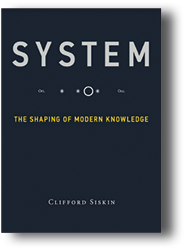 Clifford Siskin. 2016. Cambridge, MA: The MIT Press. [ISBN 978-0-262-03531-6. 318 pages, including index. US$32.00.]
Clifford Siskin. 2016. Cambridge, MA: The MIT Press. [ISBN 978-0-262-03531-6. 318 pages, including index. US$32.00.]
In a world of complex, interacting systems, many of which we document, it seems surprising there’s any need to define something as obvious as “system.” But that obviousness means we must step back and carefully rethink what “system” means and how that meaning shapes our interactions with systems. In System: The Shaping of Modern Knowledge, Siskin takes us on a voyage from the Enlightenment to today to show how we’ve reached our current modus vivendi with systems. Like any tool for imposing order on the world, system helps us reshape, reorganize, and cope with the world’s knowledge cornucopia.
“Histories can work like camera lenses, capturing an object from different angles” (p. 75). Siskin describes system’s history from a cultural studies perspective. That’s off-putting if you’re unfamiliar with concepts such as genre, disciplinarity, travel, and culture. Beginning with Galileo’s discovery of how Jupiter’s moons revealed (orbital) systems within systems, Bacon’s Novum Organum Scientarum, and Newton’s Principia, Siskin leads us on a merry intellectual romp through the past 500 years, name-checking Adam Smith, Malthus, Wordsworth, Darwin, and Dawkins, among others. These peregrinations don’t always seem coherent or in clear pursuit of what system has become. Nonetheless, Siskin proposes a working definition to frame these explorations: “how knowledge is generalized, shaped, and put to work in the world” (p. 3).
To fully appreciate System requires broad and deep reading in history and literature; it assumes too much prior knowledge for those who, like me, have only read broadly. Providing more explicit context would clarify many nuances I sensed but didn’t fully grasp. Thus, the book will be most interesting to academics (especially in cultural studies), but there’s much to interest practitioners. Systems shape thoughts and actions; recognizing their effects lets us ponder how they shape the behaviors, constraints, and possibilities our diverse audiences face—and thus, how best to communicate with them.
Dating system to the Enlightenment, based on statistical analysis of a large corpus of text from this era, seems flawed. Systems have constrained and shaped knowledge and thought for millennia; consider, for example, the memory palace systems of the classical Greeks and Romans. The Enlightenment taught us we can know the world from the evidence of our senses, not solely from received authority. In that context, system helps us assemble evidence into coherent wholes. Grasping something by naming it makes that name a powerful tool, but in this case, Siskin’s focus on etymology may have missed the true origins of system.
Siskin never synthesizes his wanderings. Though he describes the historical oscillation between efforts to build master systems that encompass the world and narrower subsystems (“disciplines”) that focus on the details, he never explicitly states this oscillation’s importance: the progress of knowledge from overview to intense focus and back again is crucial for expanding our understanding and for communicating complexity. System’s Coda is an exuberant “where we go from here” that leads from disciplinarity to “dedisciplinarity” (akin to E. O. Wilson’s “consilience”), and will inspire discussion, but proves unsatisfying in its lack of a final synthesis of where we’ve arrived.
Geoff Hart
Geoff Hart, an STC Fellow with nearly 30 years of writing, editing, translation, and information design experience, is the author of two popular books, Effective Onscreen Editing and Writing for Science Journals.
Reason & Rigor: How Conceptual Frameworks Guide Research
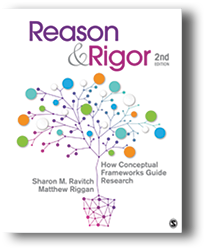 Sharon M. Ravitch and Matthew Riggan. 2017. 2nd ed. Thousand Oak, CA: Sage Publications. [ISBN 978-1-4833-4040-1. 234 pages, including index. US$60.00 (softcover).]
Sharon M. Ravitch and Matthew Riggan. 2017. 2nd ed. Thousand Oak, CA: Sage Publications. [ISBN 978-1-4833-4040-1. 234 pages, including index. US$60.00 (softcover).]
Rigor & Research: How Conceptual Frameworks Guide Research, Second Edition, provides excellent guidance for using conceptual frameworks for both quantitative and qualitative research. Students in technical communication graduate programs that require research theses or dissertations and technical communicators planning research projects will find Rigor & Research extremely helpful.
The authors explain that “a conceptual framework is an argument about why the topic one wishes to study matters, and why the means propose to study it are appropriate and rigorous” (p. 5). Well-developed conceptual frameworks provide keys to conducting quality empirical research as they apply to diverse academic disciplines.
Rigor & Research provides nine useful chapters. Chapter 1 introduces the idea of conceptual frameworks. Chapter 2 explains how researchers use conceptual frameworks to develop and guide their investigations.
Chapters 3 through 8 provide guidelines for specific sections of articles and reports, and then illustrate them with examples from journal articles written by leading researchers in education, anthropology, psychology, linguistics, and major social science disciplines.
In Chapter 3, Ravitch and Riggan use Dr. Angela Lee Duckworth’s first article on grit (“Grit: Perseverance and Passion for Long-Term Goals.” [Duckworth, A.D., Peterson, C., Matthews, M. & Kelly, D.R. (2007), Journal of Personality and Social Psychology, 92(6), 1087]. Grit (a psychological concept) explains, in part, why individuals succeed at school and work. To begin, Ravitch and Riggan review how Duckworth’s early career shaped her thinking, then they show how Duckworth proposed the concept of “grit.” Next, Ravitch and Riggan show how Duckworth compared and contrasted grit, talent, and personality factors (variables). To close their introduction, Duckworth and her co-authors explained their research objective: “In the absence of adequate existing measures, we developed and validated a self-report questionnaire called the Grit Scale” to develop a scale (series of questions) to measure “grit” (p. 43).
Chapter 4 explains how conceptual frameworks guide developing research questions and the research design. Chapter 5 focuses on conceptual frameworks and methodologies guiding data collection and fieldwork. Chapter 6 provides guidelines for data analysis. Chapter 7 focuses on how conceptual frameworks can guide researchers’ presentations, explanations, and contextualize their findings. Chapter 8 explains how William K. Dunworth developed the conceptual framework for his studies and how they evolved. Chapter 9 provides specific guidance on using conceptual frameworks. Its questions, presented in boxed panels, can help guide graduate students through their research. Ravitch and Riggan discuss the value of concept maps in visualizing the interlinking of key concepts in mapping a theory.
Throughout their nine chapters, Ravitch and Riggan cite more than 100 journal articles and books supporting the second edition of Rigor & Research. The author’s explanations of conceptual frameworks and guidelines can enhance researchers’ investigations of the complexities of technical, science, and specialized communication.
Don Zimmerman
Don Zimmerman is an STC Fellow and Jay R. Gould Award recipient. He taught technical communication classes and conducted research at Colorado State University’s Department of Journalism and Technical Communication. Don’s 150 publications include journal articles, book chapters, technical reports, presentations, newspaper and magazine articles, media productions, and books.
Odyssey—The Business of Consulting: How to Build, Grow, and Transform Your Consulting Business
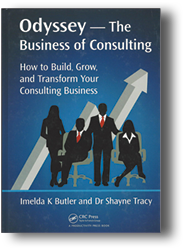 Imelda K. Butler and Dr. Shayne Tracy. 2015. Boca Raton, FL: CRC Press. [ISBN 978-1-4987-2912-3. 196 pages, including index. US$39.95.]
Imelda K. Butler and Dr. Shayne Tracy. 2015. Boca Raton, FL: CRC Press. [ISBN 978-1-4987-2912-3. 196 pages, including index. US$39.95.]
Odyssey—The Business of Consulting: How to Build, Grow, and Transform Your Consulting Business presents a solution-focused look at being an effective consultant. The authors identify four stages which consultants must go through to attain mastery at their trade: The Good Soldier, The Competent Warrior, The Trusted Advisor, and The Master Practitioner. The book then lays out a road map for moving up through the stages over time, a process the authors call “Odyssey,” drawing on the Greek epic. They argue that though making a living as a consultant is a difficult path to follow, it is attainable through their program.
The book is filled with useful knowledge about the business of consulting such as identifying your ideal client, doing research on a prospective client, organizing what they call a “Business Management Review,” or a process that a consultant leads the client’s team through to gain a better understanding of barriers within the client organization. The rest of the Odyssey process involves developing a firm relationship with clients, helping improve the way their organizations are run, and developing a trusted name for yourself as a consultant.
For this reviewer, this is where the book’s utility ends, however. As a technical communication consultant for some years now, I am always looking for new tips on how to improve my work as a consultant. And this is a book I wish I’d had when I first started consulting several years ago, as I really had no idea how to develop an ideal client profile or conduct a review of a client’s business. The more you read Odyssey—The Business of Consulting, however, the more you realize that the book is not for all consultants. The type of consultant the book is clearly geared towards are those working within the field of “management consulting,” a field dominated by corporate executives who have left their management roles to consult with other businesses.
As a consultant who helps solve communication-related problems, I found that most of the case studies, exercises, and field-specific advice didn’t apply to me. What I did find useful, and what I think others within technical communication who want to do consulting may find useful, was the approach to developing an ideal client profile, which I mentioned above. Ultimately, the book has a lot of good information on what good consultants do for a living, but I’m not sure how useful it will be to readers who want to launch consulting practices based in technical communication-related skill sets.
Guiseppe Getto
Guiseppe Getto is a faculty member at East Carolina University. He is also President and Co-Founder of Content Garden, Inc., a digital marketing and UX consulting firm.
The Word Detective: Searching for the Meaning of It All at the Oxford English Dictionary: A Memoir
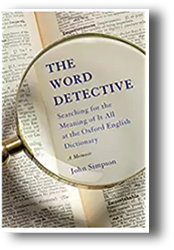 John Simpson. 2016. New York, NY: Basic Books [ISBN 978-0-465-06069-6. 365 pages, including index. US$27.99.]
John Simpson. 2016. New York, NY: Basic Books [ISBN 978-0-465-06069-6. 365 pages, including index. US$27.99.]
In 1755, Dr. Samuel Johnson published a dictionary that would be used for 150 or so years. It was prescriptive and based meanings on usage. In 1844, members of the London Philological Society decided to publish a new dictionary that was descriptive and based on historical principles. After extensive negotiations, Oxford University Press (OUP) agreed to publish it. Both the Society and the Press expected it to take about 10 years, but it wasn’t until 1844 that the work began to appear and then in unbound “fascicles.” In 1989, a second edition incorporated the previously published Supplement and a third edition is expected in mid-2000. Along the way, the Oxford English Dictionary (OED) appeared on CD (1988) and online (2000). So, how did it move from print to digital? John Simpson’s delightful The Word Detective: Searching for the Meaning of it all at the Oxford English Dictionary: A Memoir tells us.
The book really tells two stories: Simpson’s hiring as a lexicographer at the OED and rise to become editor, guiding the conversion from print to digital, and his family’s struggles with raising a disabled daughter. If the book told only the first story, it would join a number of others that tell the same story. But, because of the second story, you get a picture of Simpson and his wife as they balance careers with care-giving.
The OED story that Simpson tells is from the inside. As always in projects of this magnitude, there are political decisions as well as decisions reached through compromise. As can be imagined, OUP was reluctant to undertake such an extensive, expensive project. Not only was a separate business entity necessary, office space, storage, and staffing were major problems. Yet, Simpson and others before and after him managed to convince the Press to undertake the project. The Word Detective details these negotiations, defeats, and ultimately victories.
The insight we gain from Simpson’s narrative is one of love and devotion for both his family and the OED. He often laments as editor that he no longer is immersed in creating entries, although he did occasionally do some. His job as editor was to manage this project and all that it entails—like deadlines, budget, hiring, etc.
Where the detective comes in is the aspect of lexicography that he thoroughly enjoys: tracking down etymologies, usages, and so forth, and turning them into entries. Scattered throughout the book are side notes where Simpson will take a word he just used and tell its story. For example, he uses “selfie” (pp. 337–338) and then explains that in 2013, it was the OED’s Word of the Year. We learn that it originated in Australia in 2002. If you are a word lover, these asides are pure gold.
As technical communicators, whose main tool is language, learning more about the OED and its evolution will help you with your work.
Tom Warren
Tom Warren is an STC Fellow, Jay R. Gould Award for Excellence recipient, and professor emeritus of English (technical writing) at Oklahoma State University, where he established the BA, MA, and PhD technical writing programs. Past president of INTECOM, he served as guest professor at the University of Paderborn, Germany.
How the Brain Processes Multimodal Technical Instructions
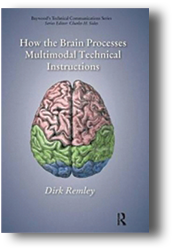 Dirk Remley. 2016. Amityville, NY: Baywood Publishing Company, Inc. [ISBN 978-0-89503-894-4. 204 pages, including index. US$80.00 (softcover).]
Dirk Remley. 2016. Amityville, NY: Baywood Publishing Company, Inc. [ISBN 978-0-89503-894-4. 204 pages, including index. US$80.00 (softcover).]
Students (and some practitioners) have heard for years that adding visuals increases understanding and retaining text. Now, Remley’s How the Brain Processes Multimodal Technical Instructions provides the research to support such an assertion. In 10 chapters plus 3 Appendices, he presents what he calls a new model of how extra elements aid cognition. His purpose is “an effort to identify a means to engage multiple fields associated with the cognitive function of learning” (p. vii). Remley further suggests that there are many problems when theories of technical communication rely on research from other fields. But, the history of technical communication makes considerable use of materials from other fields, such as psychology, sociology, biological sciences, humanities, and so forth. One glance at the table of contents of a book that surveys theories of communication (such as Littlejohn’s Theories of Human Communication) shows the influence of other disciplines. In spite of his caution, Remley joins the discussion and narrows the disciplinary focus to cognitive neuroscience and psychology.
Much of the book is really a literature review into both neuroscience and social science. Along the way, he introduces his model as supported by these research results. Chapters 1–4 establish the research basis for his model and, beginning with Chapter 5, he analyzes case studies and examines various elements that can be added to enhance cognition—slide shows and simulators (Chapter 6), videos (7), and Web sites (8). Chapter 9 presents research implications for both education and workplace training with Chapter 10 providing his conclusion and directions for future growth. Appendix A presents challenges in historical research, Appendix B lists questions used in interviews related to the explosion, and Appendix C is a radio presentation by President Franklin Delano Roosevelt on armaments (from December 29, 1940).
Remley presents a model for developing effective training materials that rests on the cognitive enhancement that multimodal elements add. The literature review for most technical communicators can become oppressive. They want a model with its literature support secondary. This problem is not to suggest that the review be eliminated for two reasons: (1) the assumed reader is really the students studying user analysis, and (2) the need for some sort of proof that the model is legitimate and works.
His model will be another way to address user analysis results—how to make the communication more effective and useful. With that focus in mind, an important readership for the book are those who prepare instructions for repetitive use. He focuses on the cognitive aspects, and that is where the neuroscience and rhetoric come in. If you need proof that learning is enhanced by using several elements in the text, then Remley is a good place to start. But be aware that the book is academic both in its style and the assumed readers.
Tom Warren
Tom Warren is an STC Fellow, Jay R. Gould Award for Excellence recipient, and professor emeritus of English (technical writing) at Oklahoma State University, where he established the BA, MA, and PhD technical writing programs. Past president of INTECOM, he served as guest professor at the University of Paderborn, Germany.
The Book: A Cover-to-Cover Exploration of the Most Powerful Object of Our Time
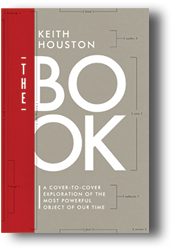 Keith Houston. 2016. New York, NY: W. W. Norton & Co., Inc. [ISBN 978-0-393-24479-3. 428 pages, including index. US$29.95.]
Keith Houston. 2016. New York, NY: W. W. Norton & Co., Inc. [ISBN 978-0-393-24479-3. 428 pages, including index. US$29.95.]
Let me say at the outset that The Book: A Cover-to-Cover Exploration of the Most Powerful Object of Our Time is the most perfect example of printing I have ever owned. I am not a book collector, but a book lover. And I absolutely love the way this book looks and feels. When you first see it, you’ll know that it is not an ordinary book, for it has callouts that describe every feature that makes a book a book. For example, on the cover, there is embossing that explains what the parts of the cover are: head, hinge, binding tape, author, title, subtitle, foot, and fore-edge. This continues through the first part of the book, but then stops when everything has been covered once.
Not only has Houston produced a beautiful and pedagogic book, but he believes in the importance of the book as an artifact: “However and whenever it was created, papyrus joined with hieroglyphics to create a self-contained mechanism for the storage and transmission of information—a pairing that endured as the premier information technology of the ancient world even as that world changed and expanded” (p. 9). Put that on your iPad and smoke it!
Houston has given us a wonderful example of technical writing as he covers the history of the book. He has detailed chapters on papyrus, parchment, paper, movable type, typesetting, illumination, woodcuts, copperplate printing, lithography, photography, and binding. If you don’t want to know how the sausage is made, this is not the book for you.
One thing I took away from the book was a new appreciation of scribes. I grew up in a church tradition that constantly denigrated scribes, so it was refreshing to read that technical communicators inherited their craft from the scribes. Scribes were so important in the ancient Egyptian world that they had their own hieroglyph. And they taught us the importance of red ink, as “red [was] employed for important text such as headings, numerical totals, and the like” (p. 88).
A scribe was also known as a “corrector,” which was “an experienced scribe engaged by more exacting scriptoria to proofread newly copied manuscripts” (p. 170). And like technical communicators, scribes often did not understand the text they were working with.
Another takeaway was that getting words and images on the same page has always been a challenge. Do you think that a Macintosh (Mac) was the first machine to wrestle with this problem? Think again. Just read the chapters on woodcuts and copperplate printing to appreciate the lengths that book developers have gone through to get a picture on the same page as print, two fundamentally different things.
You will learn many new things about The Book as you read it, and sometimes I felt he went too deeply into the weeds. But like Melville’s Moby Dick, you can skip the technical stuff to get to the heart of the story.
Charles R. Crawley
Charles R. Crawley is a technical writer for Rockwell Collins in Cedar Rapids, Iowa, and an adjunct professor at Mt. Mercy University, also in Cedar Rapids. He’s rarely met a book that he didn’t like in one way or another.
Organizations, Communication, and Health
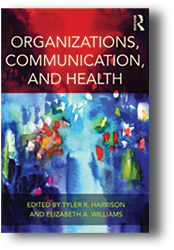 Tyler R. Harrison and Elizabeth A. Williams, eds. 2016. New York, NY: Routledge. [ISBN 978-1-138-85309-6. 438 pages, including index. US$49.95 (softcover).]
Tyler R. Harrison and Elizabeth A. Williams, eds. 2016. New York, NY: Routledge. [ISBN 978-1-138-85309-6. 438 pages, including index. US$49.95 (softcover).]
The field of communication is broad and multi-faceted. When two complex modes of communication combine problems are bound to occur. Errors in communication and understanding are especially challenging when health communication combines with organizational communication, because the patient’s health is at stake. Organizations, Communication, and Health seeks to bridge this “gap in the area of health organizations and organizing processes” (p. i).
According to the editors, the audience for this text includes “advanced undergraduate and graduate students studying health communication, as well as health professionals” (p. i). I must admit that I was skeptical about this wide range of audiences, as undergraduate and graduate students in the communication fields are likely to be less familiar with the medical examples presented, and health professionals tend to be less willing to read theoretical texts about communication. However, most of the chapters present both the examples and the theory so clearly that both scholarly and clinical audiences could follow the discussion.
Organizations, Communication, and Health is divided into three sections, exploring organizing and communication issues, the effect on individual health, and collaboration between healthcare organizations. Each chapter relates to the overarching theme using a specific theory or multiple theories to unpack an example of communication in a medical setting. The chapters are clearly organized, using descriptive headings to assist the reader in finding pertinent information. Each chapter concludes with discussion questions and suggested reading lists that are a useful guide for reflection and that serve as valuable references for further topic exploration.
The editors of Organizations, Communication, and Health asked the authors not only to identify and to explain the theory underpinning their topic but also to explore a specific project and to use the discussion of that project to illuminate the theory and the pitfalls in communication that can result. The authors rose to this challenge. The content of each chapter was relevant and presented appropriate communication theories from which both students and medical professionals could benefit. The chapters cover a wide range of theories, from Foucault’s “political technology of the body” (p. 197) to the biomedical and the biopsychosocial models of medicine (p. 122). The discussion of these theories is skillfully interwoven with examples of health communication in current contexts, such as the Ebola crisis (p. 384). These narratives serve to make complex medical and communication theories understandable on the practical level.
I found Organizations, Communication, and Health not only useful but a pleasure to read. One does not have to be an advanced communication scholar or a medical professional to learn about health and organizational communication from this text to benefit from the information presented. Because of the breadth and depth of the theories covered as well as the clear and current medical examples, I would not hesitate to use this text for an advanced health communication course or for a graduate course.
Nicole St. Germaine-Dilts
Nicole St. Germaine is an Assistant Professor in the Technical and Business Writing Program at Angelo State University, as well as a freelance writer and consultant. Her research interests include technical communication for a Mexican-American audience and technical communication in the health fields.
The Study of Language
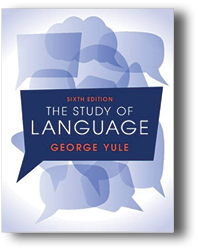 George Yule. 2017. 6th ed. Cambridge, UK: Cambridge University Press. [ISBN 978-1-107-15299-1. 356 pages, including index. US$89.99.]
George Yule. 2017. 6th ed. Cambridge, UK: Cambridge University Press. [ISBN 978-1-107-15299-1. 356 pages, including index. US$89.99.]
Knowing how the subject you are studying originated and evolved helps you understand it. Whether it is chemistry, literature, or the Constitution, origin and evolution are significant contributors to studying it in a modern context. Such is the case with language. Yule’s The Study of Language begins with theories of how language began. Some are rather fanciful, such as the “bow-wow” and “pooh-pooh” theories. Such history establishes the context for language before he discusses other aspects that the student needs to know. While language is the principle tool of technical communicators, yet, few actually study it beyond some surface elements such as grammar, rhetoric, and multimedia use. This text is an opportunity for further and deeper study.
While Yule does not divide the 20 chapters into sections, the material falls into three general groupings. The first might be labeled rules, although Yule would object to that designation. These first 8 chapters allow the student to understand the sources of various grammatical approaches from prescriptive (based on Latin grammar) to descriptive (based on how language is used). A second part, Chapters 9 to 11, describe analytical approaches. The remaining chapters (12–20) cover first and second language acquisitions (13–14), gestures and signs (15–16), written language (16), and language history and change (17). Social and cultural topics (18–20) complete the book.
As is fitting for textbooks, Yule includes many examples that do not involve technical content and that lets the reader concentrate on how the examples fit the described principles.
For technical communicators, the book could prove valuable in reviewing what is known about the language, how it is used, and how it is analyzed. Typically, the pressing deadlines most face emphasize the need to plan carefully. For example, how much time is to be devoted to developing information based on the user’s need to be helped in understanding it? Certainly, the grocery list requires much less time and careful language analysis than does a final report or scientific article. So, for this book to actually be of value to the technical communicator, it must provide needed information that the reader can quickly access.
The Study of Language includes student aids: Study Questions, Tasks, Discussion Topics/Projects, and Further Reading. A free study guide is available from the Cambridge University press Web site.
The book will help technical communicators understand approaches to language. What if a reviewer is a traditionalist and you are a descriptivist? If you are aware of where the traditionalist approach comes from, then you know how much political capital to spend in defending your approach.
As a textbook, The Study of Language has enjoyed success, appearing now in a 6th edition. As a reference and review for technical communicators, the book succeeds in bringing sufficient information about language for the technical communicator to increase user understanding.
Tom Warren
Tom Warren is an STC Fellow, Jay R. Gould Award for Excellence recipient, and professor emeritus of English (technical writing) at Oklahoma State University, where he established the BA, MA, and PhD technical writing programs. Past president of INTECOM, he served as guest professor at the University of Paderborn, Germany.

